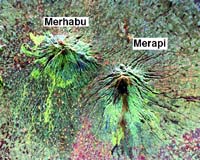 File image: Shuttle radar map of Mount Merapi. |
Mount Merapi, Indonesia, (AFP) May 13, 2006
Indonesia's Mount Merapi is the nation's second most active volcano and has great spiritual significance for those living on its fertile slopes.
Merapi, which means "Mountain of Fire", typically has small eruptions every two to three years, and larger ones about once every 10 to 15 years.
Its last major eruption was in 1994, when 66 people were killed. It also spewed smoke and lava in 2001 but no major eruption followed.
Located about 400 kilometres (250 miles) east of Jakarta in Central Java province, it looms over the Kedu plain and provides rich, bountiful soils for the thousands of people living around it.
Merapi holds particular significance for the Javanese as it is one of four places where officials from the royal palaces of Java's Yogyakarta and Solo make annual offerings to placate the spirits of ancient Javanese mythology.
Superstitious Javanese believe that a volcano's eruption is the result of spirits being angered by not receiving sufficient offerings or by a disrespectful attitude among the people living on its slopes.
Traditional beliefs hold that Merapi will only erupt after certain omens, some of which appear in dreams, leaving many residents reluctant to leave without them becoming apparent.
A new lava dome has been rapidly forming at the peak of 2,914-metre (9,616-foot) Mount Merapi, growing 75 metres in two weeks. The volcano was put on "stand-by" status one month ago.
Scientists predict that the dome's collapse will spew red-hot lava as well as deadly nuees ardentes, a geological term for clouds of volcanic gases, ash, and dust, reaching temperatures up to 500 degrees Celsius (930 degrees Fahrenheit).
Local authorities in the four districts around the volcano have already banned climbing near Merapi's peak, halted sand mining operations at its foot and warned people living higher on its slopes to be prepared for evacuation weeks ago.
Temporary shelters and vehicles have already been prepared for the evacuation, with several thousand people evacuating voluntarily but many returning to their homes.
Indonesia lies on the so-called Pacific Rim of Fire, where the meeting of continental plates causes frequent seismic and volcanic activity. The nation is home to more than 120 active volcanoes.
In August 1883, the biggest natural phenomenon ever seen on earth took place when after lying dormant for 300 years Indonesia's Krakatoa volcano burst to life, showering debris on Java and Sumatra islands and killing about 36,000 people.
The noise of the eruption reached Australia and territories located more than 4,000 kilometers away, while waves reaching up to 40 metres laid to waste nearby islands and were felt as far away as the English Channel.
Related Links
No comments:
Post a Comment